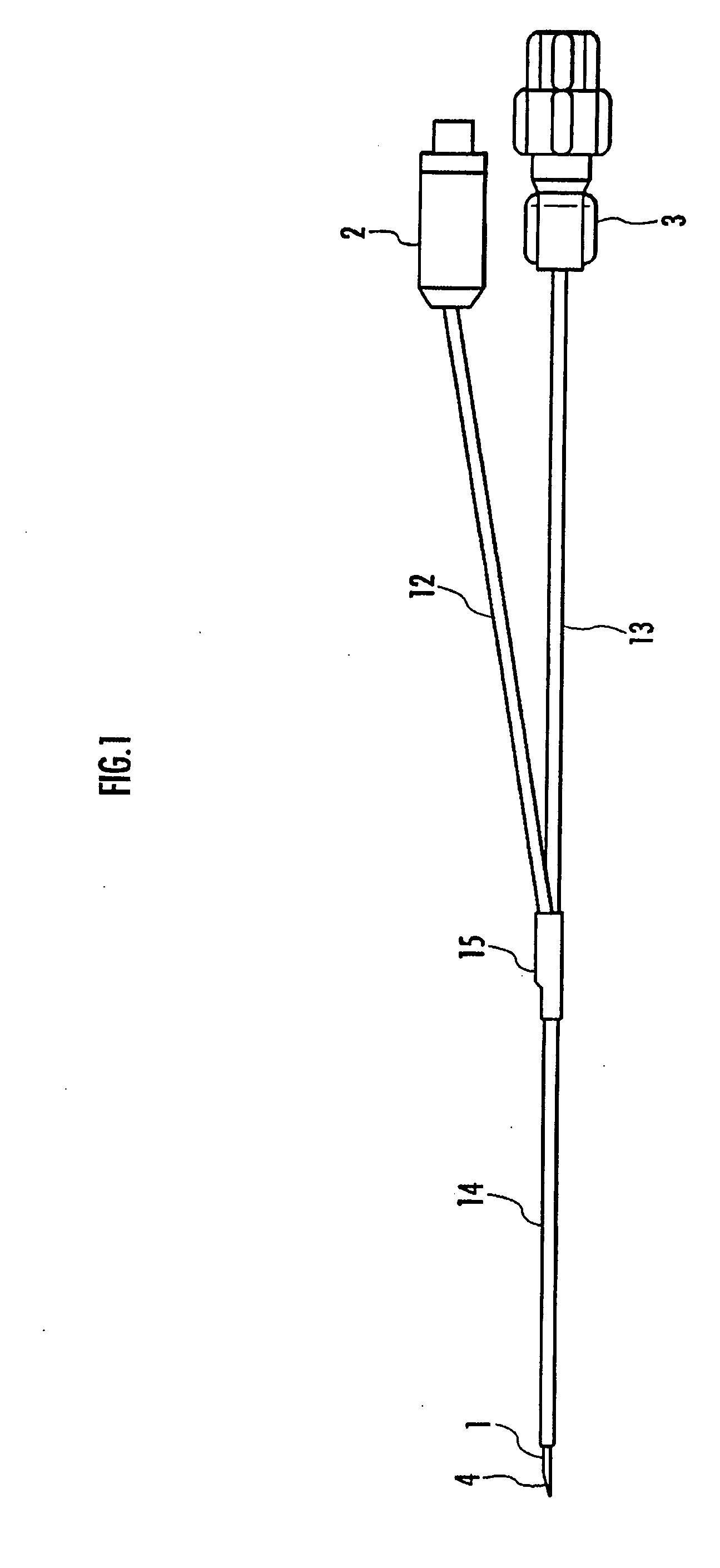Needle electrode device for medical application
a technology of a needle electrode and a needle electrode is applied in the field of needle electrode devices for medical applications, which can solve the problems of unable to obtain appropriate coagulation lesion in the affected tissue, disable accurate temperature detection, etc., and achieve the effect of reducing the piercing resistance and reliably preventing inadvertent movement or misalignment of the thermocoupl
- Summary
- Abstract
- Description
- Claims
- Application Information
AI Technical Summary
Benefits of technology
Problems solved by technology
Method used
Image
Examples
first embodiment
[0026]As shown in FIG. 1, the needle electrode device includes a needle electrode 1 to be pierced into an affected area of a living body, a first connector 2, for a connection between a feeder line and a signal line, and a second connector 3 for injecting a drug solution. The first connector 2 connects to a high frequency power source and temperature measurement means, which are not shown. The second connector 3 connects to drug solution injection means, which is not shown.
[0027]Describing the needle electrode device according to the first embodiment more specifically, as shown in FIG. 2, the needle electrode 1 is formed into a hollow stainless or other metal component having electrical conductivity and the tip of the needle electrode 1 is sharply formed with a beveled edge relative to the axis line of the needle electrode 1 as a blade surface 4.
[0028]Furthermore, a feeder line 5 is electrically connected to the outer surface of the bottom of the needle electrode 1 with solder and ...
second embodiment
[0035]Moreover, in the second embodiment, the thermocouple 6 is contained between the needle electrode 1 and the first coating material 14 as shown in FIG. 6. Therefore, the thermocouple 6 is firmly supported by the first coating material 14 and it is possible to reliably prevent an inadvertent movement or misalignment of the thermocouple 6 though the tip of the thermocouple 6 is bonded to only a part of the outer surface of the needle electrode 1.
INDUSTRIAL APPLICABILITY
[0036]As described hereinabove, according to the present invention, the needle electrode is provided with the thermocouple in a compact form and the thermocouple can detect a temperature very accurately. Therefore, the present invention can be preferably used as a needle electrode device for thermally coagulating an affected tissue by supplying radiofrequency current to a needle electrode pierced into the affected area of a living body.
PUM
 Login to View More
Login to View More Abstract
Description
Claims
Application Information
 Login to View More
Login to View More - R&D
- Intellectual Property
- Life Sciences
- Materials
- Tech Scout
- Unparalleled Data Quality
- Higher Quality Content
- 60% Fewer Hallucinations
Browse by: Latest US Patents, China's latest patents, Technical Efficacy Thesaurus, Application Domain, Technology Topic, Popular Technical Reports.
© 2025 PatSnap. All rights reserved.Legal|Privacy policy|Modern Slavery Act Transparency Statement|Sitemap|About US| Contact US: help@patsnap.com



